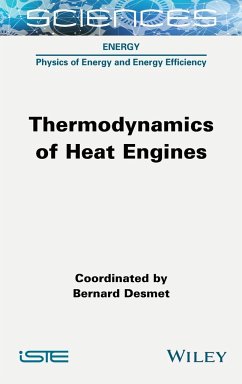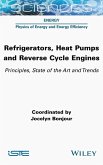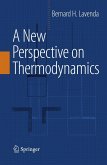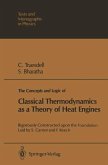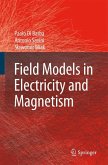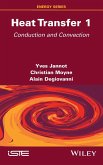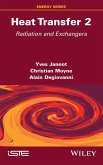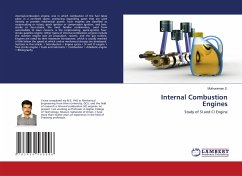Bernard Desmet
Thermodynamics of Heat Engines
Bernard Desmet
Thermodynamics of Heat Engines
- Gebundenes Buch
- Merkliste
- Auf die Merkliste
- Bewerten Bewerten
- Teilen
- Produkt teilen
- Produkterinnerung
- Produkterinnerung
Optimizing the process of converting heat into mechanical power is a major challenge when it comes to meeting targets for protecting primary energy resources and minimizing our environmental impact. For many years to come, the use of thermal engines will continue to be necessary for transportation on land, by sea and by air, as well as for many industrial applications. Against this background, Thermodynamics of Heat Engines aims to present a comprehensive overview of the thermodynamic concepts, including combustion, that are necessary for understanding the phenomena governing the energy…mehr
Andere Kunden interessierten sich auch für
![Refrigerators, Heat Pumps and Reverse Cycle Engines Refrigerators, Heat Pumps and Reverse Cycle Engines]() Refrigerators, Heat Pumps and Reverse Cycle Engines172,99 €
Refrigerators, Heat Pumps and Reverse Cycle Engines172,99 €![A New Perspective on Thermodynamics A New Perspective on Thermodynamics]() Bernard H. LavendaA New Perspective on Thermodynamics77,99 €
Bernard H. LavendaA New Perspective on Thermodynamics77,99 €![The Concepts and Logic of Classical Thermodynamics as a Theory of Heat Engines The Concepts and Logic of Classical Thermodynamics as a Theory of Heat Engines]() Clifford A. TruesdellThe Concepts and Logic of Classical Thermodynamics as a Theory of Heat Engines41,99 €
Clifford A. TruesdellThe Concepts and Logic of Classical Thermodynamics as a Theory of Heat Engines41,99 €![Field Models in Electricity and Magnetism Field Models in Electricity and Magnetism]() Paolo Di BarbaField Models in Electricity and Magnetism81,99 €
Paolo Di BarbaField Models in Electricity and Magnetism81,99 €![Heat Transfer, Volume 1 Heat Transfer, Volume 1]() Yves JannotHeat Transfer, Volume 1172,99 €
Yves JannotHeat Transfer, Volume 1172,99 €![Heat Transfer, Volume 2 Heat Transfer, Volume 2]() Yves JannotHeat Transfer, Volume 2172,99 €
Yves JannotHeat Transfer, Volume 2172,99 €![Internal Combustion Engines Internal Combustion Engines]() Muthuraman SInternal Combustion Engines37,99 €
Muthuraman SInternal Combustion Engines37,99 €-
-
-
Optimizing the process of converting heat into mechanical power is a major challenge when it comes to meeting targets for protecting primary energy resources and minimizing our environmental impact. For many years to come, the use of thermal engines will continue to be necessary for transportation on land, by sea and by air, as well as for many industrial applications. Against this background, Thermodynamics of Heat Engines aims to present a comprehensive overview of the thermodynamic concepts, including combustion, that are necessary for understanding the phenomena governing the energy efficiency of internal and external combustion engines as well as that of gas turbines and jet propulsion engines. Existing and developing industrial applications, based on combined heat and power (CHP) or the use of staged cycles, are presented, with particular attention paid to the recovery of low temperature waste heat. This book, which is mainly intended for university and engineering students but is also useful for engineers and technicians working in the fields concerned, provides a basis for reflection on the optimization of energy systems.
Hinweis: Dieser Artikel kann nur an eine deutsche Lieferadresse ausgeliefert werden.
Hinweis: Dieser Artikel kann nur an eine deutsche Lieferadresse ausgeliefert werden.
Produktdetails
- Produktdetails
- Verlag: Wiley
- Seitenzahl: 256
- Erscheinungstermin: 28. Dezember 2022
- Englisch
- Abmessung: 240mm x 161mm x 18mm
- Gewicht: 554g
- ISBN-13: 9781789450750
- ISBN-10: 1789450756
- Artikelnr.: 66353615
- Herstellerkennzeichnung
- Libri GmbH
- Europaallee 1
- 36244 Bad Hersfeld
- gpsr@libri.de
- Verlag: Wiley
- Seitenzahl: 256
- Erscheinungstermin: 28. Dezember 2022
- Englisch
- Abmessung: 240mm x 161mm x 18mm
- Gewicht: 554g
- ISBN-13: 9781789450750
- ISBN-10: 1789450756
- Artikelnr.: 66353615
- Herstellerkennzeichnung
- Libri GmbH
- Europaallee 1
- 36244 Bad Hersfeld
- gpsr@libri.de
Bernard Desmet is a former professor at ENSIAME - Université Polytechnique Hauts-de-France and has directed doctoral theses in energy. He is a member of the French Society of Heat Science (SFT).
Foreword xi
Michel FEIDT
Preface xiii
Bernard DESMET
Chapter 1 Energy Conversion: Thermodynamic Basics 1
Georges DESCOMBES and Bernard DESMET
1.1. Introduction 1
1.2. Principles of thermodynamics 2
1.2.1. Notion of a thermodynamic system 2
1.2.2.First law 2
1.2.3 Second law: mechanism of mechanical energy degradation in a heat
engine 5
1.3. Thermodynamics of gases 14
1.3.1.Equations of state 14
1.3.2.Calorimetric coefficients 15
1.3.3.Ideal gas 16
1.3.4.Van der Waals gas 20
1.4.Conclusion 21
1.5.References 21
Chapter 2 Internal Combustion Engines 23
Bernard DESMET
2.1. Generalities - Operating principles 23
2.1.1. Introduction 23
2.1.2. Spark-ignition engines 25
2.1.3. Compression ignition engine 28
2.1.4.Expression of useful work 29
2.2.Theoreticalair cycles 30
2.2.1. Hypotheses 30
2.2.2.Beau de Rochas cycle(Otto cycle) 31
2.2.3. Miller-Atkinson cycle 36
2.2.4.Diesel cycle 39
2.2.5.The limited pressure cycle (mixed cycle) 41
2.2.6.Comparison of theoretical air cycles 43
2.3 Influences of the thermos physical properties of the working fluid on
the theoretical cycles 43
2.3.1. Thermophysical properties of the working fluid 43
2.3.2.Reversible adiabatic transformations 45
2.3.3.Mixed cycle for ideal and semi-ideal gases 47
2.4. Zero-dimensional thermodynamic models 51
2.4.1. Hypotheses 51
2.4.2.Single-zonemodel 52
2.4.3. Flow through the valves 54
2.4.4.Heat transfer with the cylinder walls 56
2.4.5.Combustion heat generation model 57
2.4.6.Two-zonemodel 59
2.5. Supercharging of internal combustion engines 61
2.5.1.Basic principles of super charging 61
2.5.2.Supercharging by a driven compressor 62
2.5.3.Turbocharging 63
2.6.Conclusions and perspectives 66
2.7.References 67
Chapter 3 Aeronautical and Space Propulsion 69
Yannick MULLER and François COTTIER
3.1. History and development of aeronautical means of propulsion 69
3.2. Presentation of the aircraft system and its propulsive unit 72
3.2.1. Classification and presentation of the usual architectures of
aeronautical engines and their specific uses 72
3.2.2 Study of the forces applied on the aircraft system during steady
flight 79
3.2.3. Definition of the propulsion forces and specific quantities of the
propulsion system 83
3.3.Operating cycle analysis 86
3.3.1. Hypotheses and limits of validity 86
3.3.2. Presentation of engine stations (SAE ARP 755 STANDARD) 88
3.3.3 Study of thermodynamic transformations and their representations in
T-s diagrams 91
3.3.4. Study of the thermodynamic cycles for a gas turbine 93
3.3.5 Study of the thermodynamic cycle of a gas turbine, branch by branch
96
3.3.6. Improvements to the Joule-Brayton cycle 98
3.3.7 Thermodynamic improvements for a gas turbine using energy
regeneration 101
3.3.8 Thermodynamic improvements for a gas turbine using staged compression
and expansion 103
3.4.The actual engine 104
3.4.1. Development cycle of the turbomachine (turbojet) 104
3.4.2. Technical disciplines in development 108
3.4.3. Some specific problems of each module 111
3.4.4. Secondary air system design methods 125
3.4.5. T4 and the secondary air system 126
3.5.Perspectives 132
3.6.References 132
Chapter 4 Combustion and Conversion of Energy 133
Bernard DESMET
4.1. Generalities 133
4.1.1. Introduction 133
4.1.2.Premixed flame 135
4.1.3.Diffusion flame 136
4.1.4.Stabilization of a flame 137
4.1.5. Flammability of air-fuel mixtures 138
4.1.6. Combustion in internal combustion engines 139
4.2.Theoretical combustion reactions 141
4.2.1. Constituents of the combustible mixture 141
4.2.2.Combustion stoichiometry 142
4.2.3. Theoretical combustion of a lean mixture 143
4.2.4. Theoretical combustion of a rich mixture 144
4.3.Energy study of combustion 144
4.3.1.Combustion at constant volume 144
4.3.2.Combustion at constant pressure 146
4.3.3.Relations between heating values 147
4.3.4. Adiabatic flame and explosion temperatures 150
4.4.Chemical kinetics of combustion 155
4.4.1.Chain reactions 155
4.4.2. Composition of a reactive mixture 156
4.4.3.Reactionrates 157
4.4.4. Establishing a chemical equilibrium 159
4.4.5. Equilibrium composition of the combustion products 160
4.4.6. Detailed chemical kinetics-formation of pollutants 164
4.5.Exergy analysis of combustion 166
4.5.1.Exergy of a gas mixture 166
4.5.2. Exergy production from a combustion reaction 169
4.5.3.Exergy of a fuel 172
4.6.Conclusion 176
4.7.References 176
Chapter 5 Engines with an External Heat Supply 179
Georges DESCOMBES and Bernard DESMET
5.1. Introduction 179
5.2.The Stirling engine 180
5.2.1.The oretical cycle 180
5.2.2.Characteristics of the Stirling engine 184
5.3.The Ericsson engine 187
5.3.1.Operating principles 187
5.3.2.Theoreticalcycles 188
5.3.3. Improvements of the Ericsson engine 193
5.4.Perspectives 194
5.4.1. Advantages and disadvantages of Stirling and Ericsson engines 194
5.4.2. Perspectives of evolution of external combustion machines in the new
decarbonized energy landscape 195
5.5.References 195
Chapter 6 Energy Recovery - Waste Heat Recovery 197
Mohamed MEBARKIA
6.1.Waste energy recovery 197
6.1.1. Energy balance of an internal combustion engine 197
6.1.2. Degradation of mechanizable energy into uncompensated heat 200
6.1.3. Exergy balance in internal combustion engines 203
6.1.4.Concept of energy recovery 205
6.2. Cogeneration in industrial facilities 205
6.2.1.Cogenerating gas turbines 205
6.2.2.Cogenerating diesel engine 207
6.2.3.Comparative cogeneration efficiencies 209
6.2.4.Complex depressurized cycle 211
6.2.5.Complex over-expansion cycle 212
6.2.6.Conclusion 214
6.3.Micro-cogeneration 215
6.3.1. Introduction 215
6.3.2.Classification 216
6.3.3.Internal combustion engines 217
6.3.4.Gasmicro-turbines 218
6.3.5.Fuelcells 221
6.3.6.Thermoelectricity 223
6.3.7.Thermoacoustics 224
6.3.8."Rankinized"cycles 225
6.4.Conclusion 227
6.5.Perspectives 228
6.6.References 229
List of Authors 233
Index 235
Michel FEIDT
Preface xiii
Bernard DESMET
Chapter 1 Energy Conversion: Thermodynamic Basics 1
Georges DESCOMBES and Bernard DESMET
1.1. Introduction 1
1.2. Principles of thermodynamics 2
1.2.1. Notion of a thermodynamic system 2
1.2.2.First law 2
1.2.3 Second law: mechanism of mechanical energy degradation in a heat
engine 5
1.3. Thermodynamics of gases 14
1.3.1.Equations of state 14
1.3.2.Calorimetric coefficients 15
1.3.3.Ideal gas 16
1.3.4.Van der Waals gas 20
1.4.Conclusion 21
1.5.References 21
Chapter 2 Internal Combustion Engines 23
Bernard DESMET
2.1. Generalities - Operating principles 23
2.1.1. Introduction 23
2.1.2. Spark-ignition engines 25
2.1.3. Compression ignition engine 28
2.1.4.Expression of useful work 29
2.2.Theoreticalair cycles 30
2.2.1. Hypotheses 30
2.2.2.Beau de Rochas cycle(Otto cycle) 31
2.2.3. Miller-Atkinson cycle 36
2.2.4.Diesel cycle 39
2.2.5.The limited pressure cycle (mixed cycle) 41
2.2.6.Comparison of theoretical air cycles 43
2.3 Influences of the thermos physical properties of the working fluid on
the theoretical cycles 43
2.3.1. Thermophysical properties of the working fluid 43
2.3.2.Reversible adiabatic transformations 45
2.3.3.Mixed cycle for ideal and semi-ideal gases 47
2.4. Zero-dimensional thermodynamic models 51
2.4.1. Hypotheses 51
2.4.2.Single-zonemodel 52
2.4.3. Flow through the valves 54
2.4.4.Heat transfer with the cylinder walls 56
2.4.5.Combustion heat generation model 57
2.4.6.Two-zonemodel 59
2.5. Supercharging of internal combustion engines 61
2.5.1.Basic principles of super charging 61
2.5.2.Supercharging by a driven compressor 62
2.5.3.Turbocharging 63
2.6.Conclusions and perspectives 66
2.7.References 67
Chapter 3 Aeronautical and Space Propulsion 69
Yannick MULLER and François COTTIER
3.1. History and development of aeronautical means of propulsion 69
3.2. Presentation of the aircraft system and its propulsive unit 72
3.2.1. Classification and presentation of the usual architectures of
aeronautical engines and their specific uses 72
3.2.2 Study of the forces applied on the aircraft system during steady
flight 79
3.2.3. Definition of the propulsion forces and specific quantities of the
propulsion system 83
3.3.Operating cycle analysis 86
3.3.1. Hypotheses and limits of validity 86
3.3.2. Presentation of engine stations (SAE ARP 755 STANDARD) 88
3.3.3 Study of thermodynamic transformations and their representations in
T-s diagrams 91
3.3.4. Study of the thermodynamic cycles for a gas turbine 93
3.3.5 Study of the thermodynamic cycle of a gas turbine, branch by branch
96
3.3.6. Improvements to the Joule-Brayton cycle 98
3.3.7 Thermodynamic improvements for a gas turbine using energy
regeneration 101
3.3.8 Thermodynamic improvements for a gas turbine using staged compression
and expansion 103
3.4.The actual engine 104
3.4.1. Development cycle of the turbomachine (turbojet) 104
3.4.2. Technical disciplines in development 108
3.4.3. Some specific problems of each module 111
3.4.4. Secondary air system design methods 125
3.4.5. T4 and the secondary air system 126
3.5.Perspectives 132
3.6.References 132
Chapter 4 Combustion and Conversion of Energy 133
Bernard DESMET
4.1. Generalities 133
4.1.1. Introduction 133
4.1.2.Premixed flame 135
4.1.3.Diffusion flame 136
4.1.4.Stabilization of a flame 137
4.1.5. Flammability of air-fuel mixtures 138
4.1.6. Combustion in internal combustion engines 139
4.2.Theoretical combustion reactions 141
4.2.1. Constituents of the combustible mixture 141
4.2.2.Combustion stoichiometry 142
4.2.3. Theoretical combustion of a lean mixture 143
4.2.4. Theoretical combustion of a rich mixture 144
4.3.Energy study of combustion 144
4.3.1.Combustion at constant volume 144
4.3.2.Combustion at constant pressure 146
4.3.3.Relations between heating values 147
4.3.4. Adiabatic flame and explosion temperatures 150
4.4.Chemical kinetics of combustion 155
4.4.1.Chain reactions 155
4.4.2. Composition of a reactive mixture 156
4.4.3.Reactionrates 157
4.4.4. Establishing a chemical equilibrium 159
4.4.5. Equilibrium composition of the combustion products 160
4.4.6. Detailed chemical kinetics-formation of pollutants 164
4.5.Exergy analysis of combustion 166
4.5.1.Exergy of a gas mixture 166
4.5.2. Exergy production from a combustion reaction 169
4.5.3.Exergy of a fuel 172
4.6.Conclusion 176
4.7.References 176
Chapter 5 Engines with an External Heat Supply 179
Georges DESCOMBES and Bernard DESMET
5.1. Introduction 179
5.2.The Stirling engine 180
5.2.1.The oretical cycle 180
5.2.2.Characteristics of the Stirling engine 184
5.3.The Ericsson engine 187
5.3.1.Operating principles 187
5.3.2.Theoreticalcycles 188
5.3.3. Improvements of the Ericsson engine 193
5.4.Perspectives 194
5.4.1. Advantages and disadvantages of Stirling and Ericsson engines 194
5.4.2. Perspectives of evolution of external combustion machines in the new
decarbonized energy landscape 195
5.5.References 195
Chapter 6 Energy Recovery - Waste Heat Recovery 197
Mohamed MEBARKIA
6.1.Waste energy recovery 197
6.1.1. Energy balance of an internal combustion engine 197
6.1.2. Degradation of mechanizable energy into uncompensated heat 200
6.1.3. Exergy balance in internal combustion engines 203
6.1.4.Concept of energy recovery 205
6.2. Cogeneration in industrial facilities 205
6.2.1.Cogenerating gas turbines 205
6.2.2.Cogenerating diesel engine 207
6.2.3.Comparative cogeneration efficiencies 209
6.2.4.Complex depressurized cycle 211
6.2.5.Complex over-expansion cycle 212
6.2.6.Conclusion 214
6.3.Micro-cogeneration 215
6.3.1. Introduction 215
6.3.2.Classification 216
6.3.3.Internal combustion engines 217
6.3.4.Gasmicro-turbines 218
6.3.5.Fuelcells 221
6.3.6.Thermoelectricity 223
6.3.7.Thermoacoustics 224
6.3.8."Rankinized"cycles 225
6.4.Conclusion 227
6.5.Perspectives 228
6.6.References 229
List of Authors 233
Index 235
Foreword xi
Michel FEIDT
Preface xiii
Bernard DESMET
Chapter 1 Energy Conversion: Thermodynamic Basics 1
Georges DESCOMBES and Bernard DESMET
1.1. Introduction 1
1.2. Principles of thermodynamics 2
1.2.1. Notion of a thermodynamic system 2
1.2.2.First law 2
1.2.3 Second law: mechanism of mechanical energy degradation in a heat
engine 5
1.3. Thermodynamics of gases 14
1.3.1.Equations of state 14
1.3.2.Calorimetric coefficients 15
1.3.3.Ideal gas 16
1.3.4.Van der Waals gas 20
1.4.Conclusion 21
1.5.References 21
Chapter 2 Internal Combustion Engines 23
Bernard DESMET
2.1. Generalities - Operating principles 23
2.1.1. Introduction 23
2.1.2. Spark-ignition engines 25
2.1.3. Compression ignition engine 28
2.1.4.Expression of useful work 29
2.2.Theoreticalair cycles 30
2.2.1. Hypotheses 30
2.2.2.Beau de Rochas cycle(Otto cycle) 31
2.2.3. Miller-Atkinson cycle 36
2.2.4.Diesel cycle 39
2.2.5.The limited pressure cycle (mixed cycle) 41
2.2.6.Comparison of theoretical air cycles 43
2.3 Influences of the thermos physical properties of the working fluid on
the theoretical cycles 43
2.3.1. Thermophysical properties of the working fluid 43
2.3.2.Reversible adiabatic transformations 45
2.3.3.Mixed cycle for ideal and semi-ideal gases 47
2.4. Zero-dimensional thermodynamic models 51
2.4.1. Hypotheses 51
2.4.2.Single-zonemodel 52
2.4.3. Flow through the valves 54
2.4.4.Heat transfer with the cylinder walls 56
2.4.5.Combustion heat generation model 57
2.4.6.Two-zonemodel 59
2.5. Supercharging of internal combustion engines 61
2.5.1.Basic principles of super charging 61
2.5.2.Supercharging by a driven compressor 62
2.5.3.Turbocharging 63
2.6.Conclusions and perspectives 66
2.7.References 67
Chapter 3 Aeronautical and Space Propulsion 69
Yannick MULLER and François COTTIER
3.1. History and development of aeronautical means of propulsion 69
3.2. Presentation of the aircraft system and its propulsive unit 72
3.2.1. Classification and presentation of the usual architectures of
aeronautical engines and their specific uses 72
3.2.2 Study of the forces applied on the aircraft system during steady
flight 79
3.2.3. Definition of the propulsion forces and specific quantities of the
propulsion system 83
3.3.Operating cycle analysis 86
3.3.1. Hypotheses and limits of validity 86
3.3.2. Presentation of engine stations (SAE ARP 755 STANDARD) 88
3.3.3 Study of thermodynamic transformations and their representations in
T-s diagrams 91
3.3.4. Study of the thermodynamic cycles for a gas turbine 93
3.3.5 Study of the thermodynamic cycle of a gas turbine, branch by branch
96
3.3.6. Improvements to the Joule-Brayton cycle 98
3.3.7 Thermodynamic improvements for a gas turbine using energy
regeneration 101
3.3.8 Thermodynamic improvements for a gas turbine using staged compression
and expansion 103
3.4.The actual engine 104
3.4.1. Development cycle of the turbomachine (turbojet) 104
3.4.2. Technical disciplines in development 108
3.4.3. Some specific problems of each module 111
3.4.4. Secondary air system design methods 125
3.4.5. T4 and the secondary air system 126
3.5.Perspectives 132
3.6.References 132
Chapter 4 Combustion and Conversion of Energy 133
Bernard DESMET
4.1. Generalities 133
4.1.1. Introduction 133
4.1.2.Premixed flame 135
4.1.3.Diffusion flame 136
4.1.4.Stabilization of a flame 137
4.1.5. Flammability of air-fuel mixtures 138
4.1.6. Combustion in internal combustion engines 139
4.2.Theoretical combustion reactions 141
4.2.1. Constituents of the combustible mixture 141
4.2.2.Combustion stoichiometry 142
4.2.3. Theoretical combustion of a lean mixture 143
4.2.4. Theoretical combustion of a rich mixture 144
4.3.Energy study of combustion 144
4.3.1.Combustion at constant volume 144
4.3.2.Combustion at constant pressure 146
4.3.3.Relations between heating values 147
4.3.4. Adiabatic flame and explosion temperatures 150
4.4.Chemical kinetics of combustion 155
4.4.1.Chain reactions 155
4.4.2. Composition of a reactive mixture 156
4.4.3.Reactionrates 157
4.4.4. Establishing a chemical equilibrium 159
4.4.5. Equilibrium composition of the combustion products 160
4.4.6. Detailed chemical kinetics-formation of pollutants 164
4.5.Exergy analysis of combustion 166
4.5.1.Exergy of a gas mixture 166
4.5.2. Exergy production from a combustion reaction 169
4.5.3.Exergy of a fuel 172
4.6.Conclusion 176
4.7.References 176
Chapter 5 Engines with an External Heat Supply 179
Georges DESCOMBES and Bernard DESMET
5.1. Introduction 179
5.2.The Stirling engine 180
5.2.1.The oretical cycle 180
5.2.2.Characteristics of the Stirling engine 184
5.3.The Ericsson engine 187
5.3.1.Operating principles 187
5.3.2.Theoreticalcycles 188
5.3.3. Improvements of the Ericsson engine 193
5.4.Perspectives 194
5.4.1. Advantages and disadvantages of Stirling and Ericsson engines 194
5.4.2. Perspectives of evolution of external combustion machines in the new
decarbonized energy landscape 195
5.5.References 195
Chapter 6 Energy Recovery - Waste Heat Recovery 197
Mohamed MEBARKIA
6.1.Waste energy recovery 197
6.1.1. Energy balance of an internal combustion engine 197
6.1.2. Degradation of mechanizable energy into uncompensated heat 200
6.1.3. Exergy balance in internal combustion engines 203
6.1.4.Concept of energy recovery 205
6.2. Cogeneration in industrial facilities 205
6.2.1.Cogenerating gas turbines 205
6.2.2.Cogenerating diesel engine 207
6.2.3.Comparative cogeneration efficiencies 209
6.2.4.Complex depressurized cycle 211
6.2.5.Complex over-expansion cycle 212
6.2.6.Conclusion 214
6.3.Micro-cogeneration 215
6.3.1. Introduction 215
6.3.2.Classification 216
6.3.3.Internal combustion engines 217
6.3.4.Gasmicro-turbines 218
6.3.5.Fuelcells 221
6.3.6.Thermoelectricity 223
6.3.7.Thermoacoustics 224
6.3.8."Rankinized"cycles 225
6.4.Conclusion 227
6.5.Perspectives 228
6.6.References 229
List of Authors 233
Index 235
Michel FEIDT
Preface xiii
Bernard DESMET
Chapter 1 Energy Conversion: Thermodynamic Basics 1
Georges DESCOMBES and Bernard DESMET
1.1. Introduction 1
1.2. Principles of thermodynamics 2
1.2.1. Notion of a thermodynamic system 2
1.2.2.First law 2
1.2.3 Second law: mechanism of mechanical energy degradation in a heat
engine 5
1.3. Thermodynamics of gases 14
1.3.1.Equations of state 14
1.3.2.Calorimetric coefficients 15
1.3.3.Ideal gas 16
1.3.4.Van der Waals gas 20
1.4.Conclusion 21
1.5.References 21
Chapter 2 Internal Combustion Engines 23
Bernard DESMET
2.1. Generalities - Operating principles 23
2.1.1. Introduction 23
2.1.2. Spark-ignition engines 25
2.1.3. Compression ignition engine 28
2.1.4.Expression of useful work 29
2.2.Theoreticalair cycles 30
2.2.1. Hypotheses 30
2.2.2.Beau de Rochas cycle(Otto cycle) 31
2.2.3. Miller-Atkinson cycle 36
2.2.4.Diesel cycle 39
2.2.5.The limited pressure cycle (mixed cycle) 41
2.2.6.Comparison of theoretical air cycles 43
2.3 Influences of the thermos physical properties of the working fluid on
the theoretical cycles 43
2.3.1. Thermophysical properties of the working fluid 43
2.3.2.Reversible adiabatic transformations 45
2.3.3.Mixed cycle for ideal and semi-ideal gases 47
2.4. Zero-dimensional thermodynamic models 51
2.4.1. Hypotheses 51
2.4.2.Single-zonemodel 52
2.4.3. Flow through the valves 54
2.4.4.Heat transfer with the cylinder walls 56
2.4.5.Combustion heat generation model 57
2.4.6.Two-zonemodel 59
2.5. Supercharging of internal combustion engines 61
2.5.1.Basic principles of super charging 61
2.5.2.Supercharging by a driven compressor 62
2.5.3.Turbocharging 63
2.6.Conclusions and perspectives 66
2.7.References 67
Chapter 3 Aeronautical and Space Propulsion 69
Yannick MULLER and François COTTIER
3.1. History and development of aeronautical means of propulsion 69
3.2. Presentation of the aircraft system and its propulsive unit 72
3.2.1. Classification and presentation of the usual architectures of
aeronautical engines and their specific uses 72
3.2.2 Study of the forces applied on the aircraft system during steady
flight 79
3.2.3. Definition of the propulsion forces and specific quantities of the
propulsion system 83
3.3.Operating cycle analysis 86
3.3.1. Hypotheses and limits of validity 86
3.3.2. Presentation of engine stations (SAE ARP 755 STANDARD) 88
3.3.3 Study of thermodynamic transformations and their representations in
T-s diagrams 91
3.3.4. Study of the thermodynamic cycles for a gas turbine 93
3.3.5 Study of the thermodynamic cycle of a gas turbine, branch by branch
96
3.3.6. Improvements to the Joule-Brayton cycle 98
3.3.7 Thermodynamic improvements for a gas turbine using energy
regeneration 101
3.3.8 Thermodynamic improvements for a gas turbine using staged compression
and expansion 103
3.4.The actual engine 104
3.4.1. Development cycle of the turbomachine (turbojet) 104
3.4.2. Technical disciplines in development 108
3.4.3. Some specific problems of each module 111
3.4.4. Secondary air system design methods 125
3.4.5. T4 and the secondary air system 126
3.5.Perspectives 132
3.6.References 132
Chapter 4 Combustion and Conversion of Energy 133
Bernard DESMET
4.1. Generalities 133
4.1.1. Introduction 133
4.1.2.Premixed flame 135
4.1.3.Diffusion flame 136
4.1.4.Stabilization of a flame 137
4.1.5. Flammability of air-fuel mixtures 138
4.1.6. Combustion in internal combustion engines 139
4.2.Theoretical combustion reactions 141
4.2.1. Constituents of the combustible mixture 141
4.2.2.Combustion stoichiometry 142
4.2.3. Theoretical combustion of a lean mixture 143
4.2.4. Theoretical combustion of a rich mixture 144
4.3.Energy study of combustion 144
4.3.1.Combustion at constant volume 144
4.3.2.Combustion at constant pressure 146
4.3.3.Relations between heating values 147
4.3.4. Adiabatic flame and explosion temperatures 150
4.4.Chemical kinetics of combustion 155
4.4.1.Chain reactions 155
4.4.2. Composition of a reactive mixture 156
4.4.3.Reactionrates 157
4.4.4. Establishing a chemical equilibrium 159
4.4.5. Equilibrium composition of the combustion products 160
4.4.6. Detailed chemical kinetics-formation of pollutants 164
4.5.Exergy analysis of combustion 166
4.5.1.Exergy of a gas mixture 166
4.5.2. Exergy production from a combustion reaction 169
4.5.3.Exergy of a fuel 172
4.6.Conclusion 176
4.7.References 176
Chapter 5 Engines with an External Heat Supply 179
Georges DESCOMBES and Bernard DESMET
5.1. Introduction 179
5.2.The Stirling engine 180
5.2.1.The oretical cycle 180
5.2.2.Characteristics of the Stirling engine 184
5.3.The Ericsson engine 187
5.3.1.Operating principles 187
5.3.2.Theoreticalcycles 188
5.3.3. Improvements of the Ericsson engine 193
5.4.Perspectives 194
5.4.1. Advantages and disadvantages of Stirling and Ericsson engines 194
5.4.2. Perspectives of evolution of external combustion machines in the new
decarbonized energy landscape 195
5.5.References 195
Chapter 6 Energy Recovery - Waste Heat Recovery 197
Mohamed MEBARKIA
6.1.Waste energy recovery 197
6.1.1. Energy balance of an internal combustion engine 197
6.1.2. Degradation of mechanizable energy into uncompensated heat 200
6.1.3. Exergy balance in internal combustion engines 203
6.1.4.Concept of energy recovery 205
6.2. Cogeneration in industrial facilities 205
6.2.1.Cogenerating gas turbines 205
6.2.2.Cogenerating diesel engine 207
6.2.3.Comparative cogeneration efficiencies 209
6.2.4.Complex depressurized cycle 211
6.2.5.Complex over-expansion cycle 212
6.2.6.Conclusion 214
6.3.Micro-cogeneration 215
6.3.1. Introduction 215
6.3.2.Classification 216
6.3.3.Internal combustion engines 217
6.3.4.Gasmicro-turbines 218
6.3.5.Fuelcells 221
6.3.6.Thermoelectricity 223
6.3.7.Thermoacoustics 224
6.3.8."Rankinized"cycles 225
6.4.Conclusion 227
6.5.Perspectives 228
6.6.References 229
List of Authors 233
Index 235

